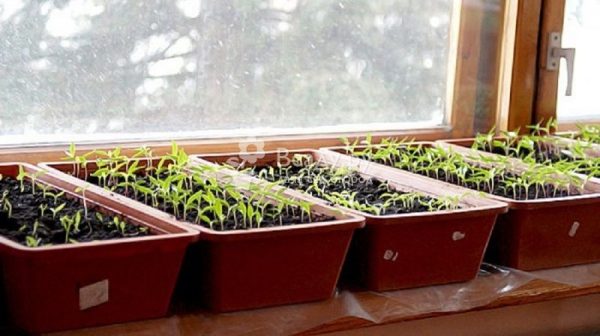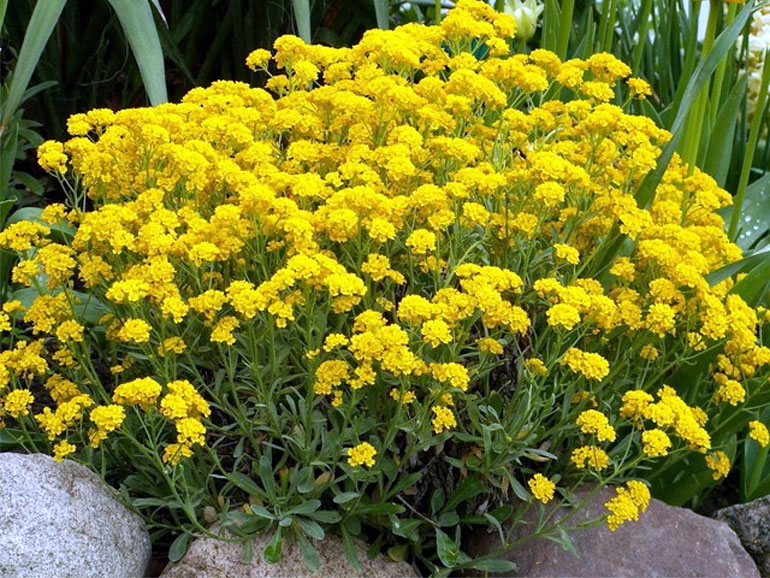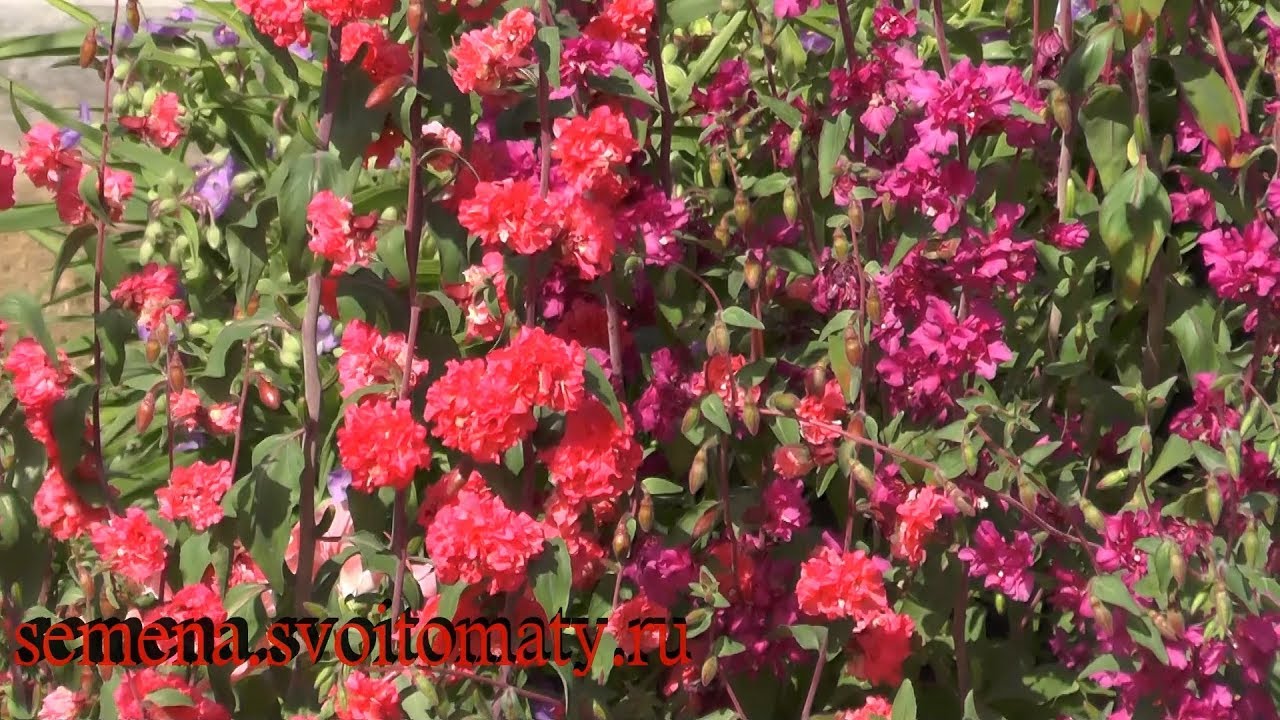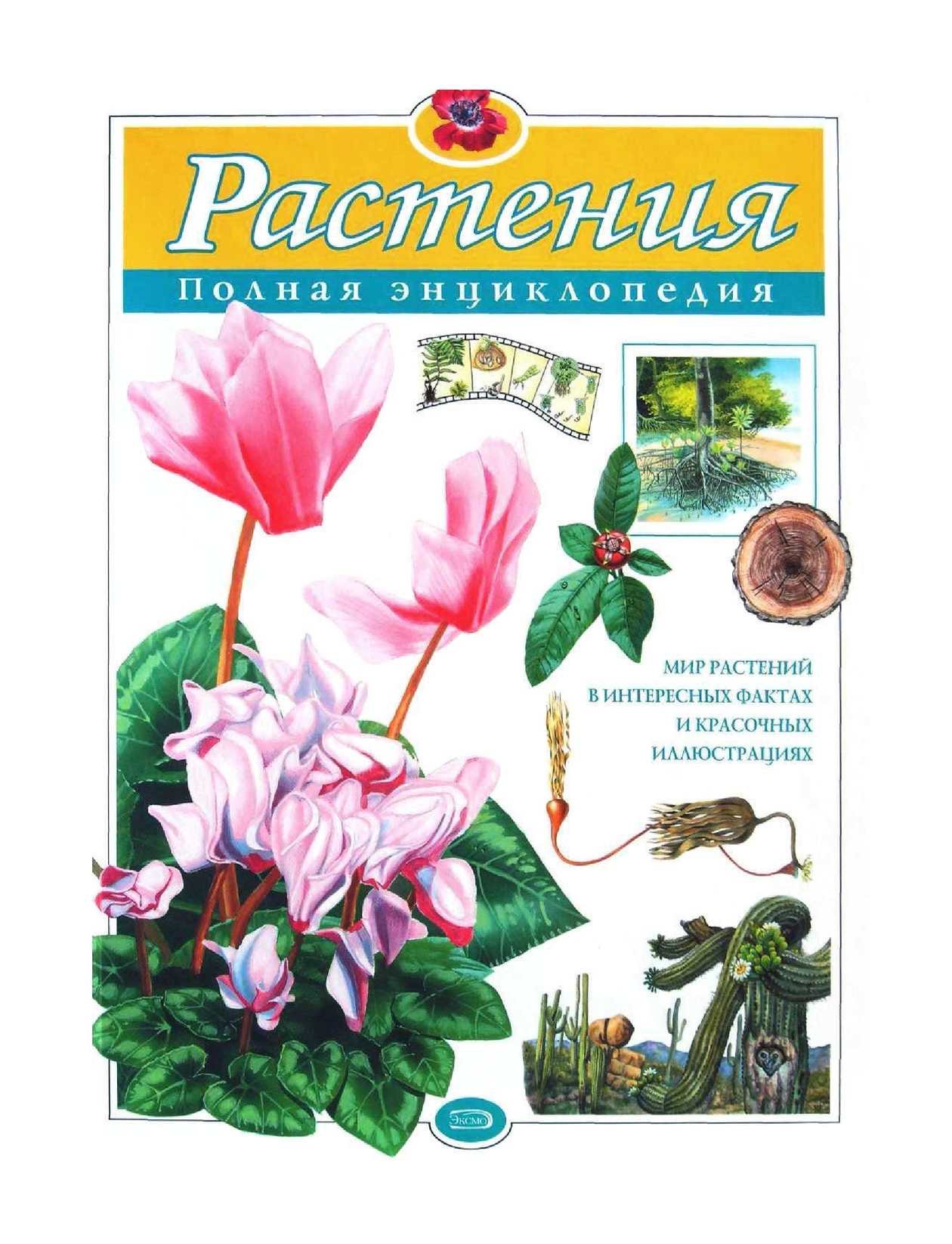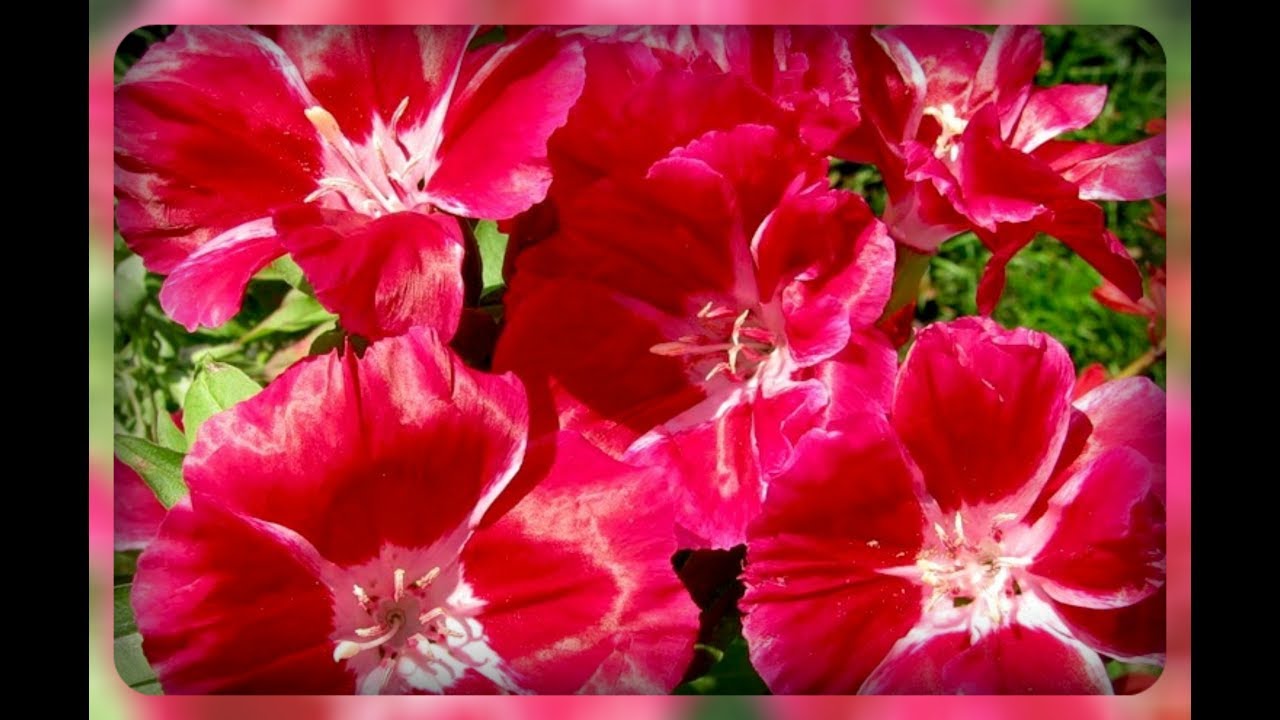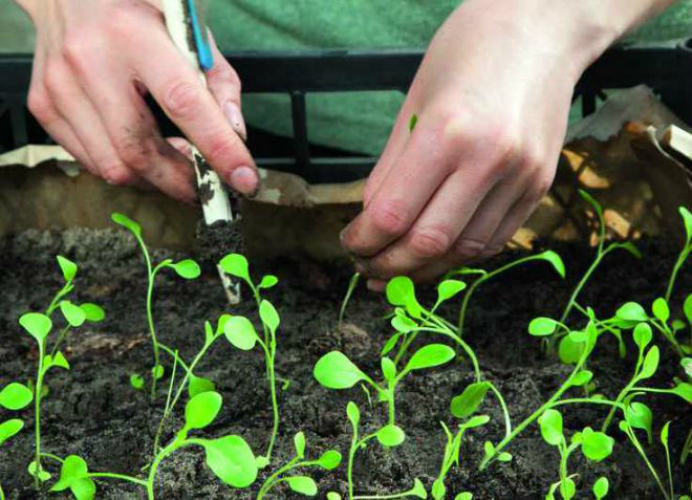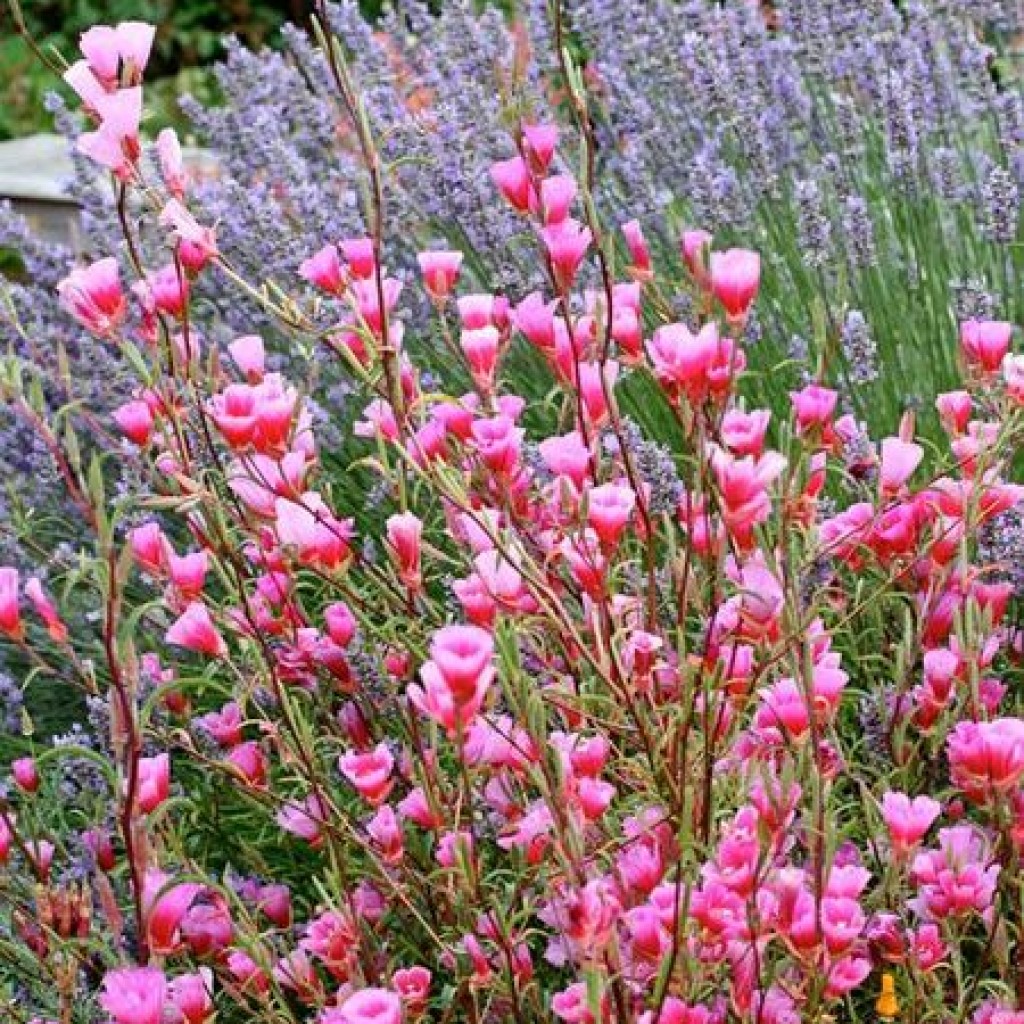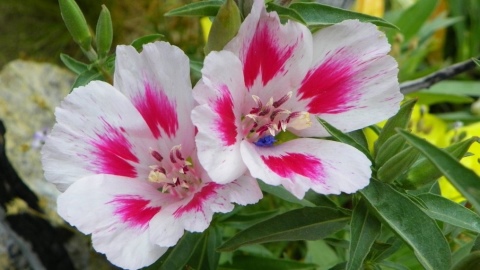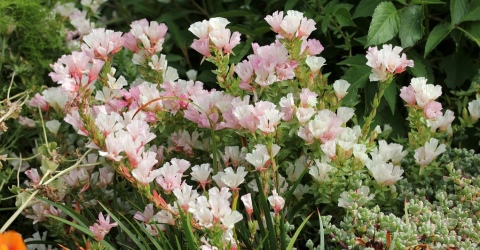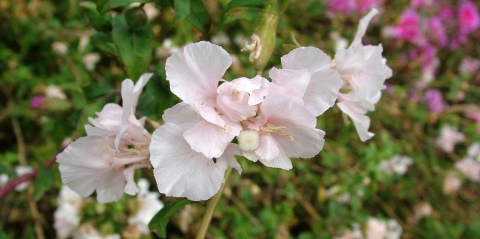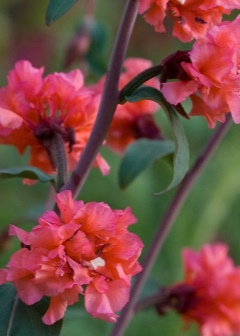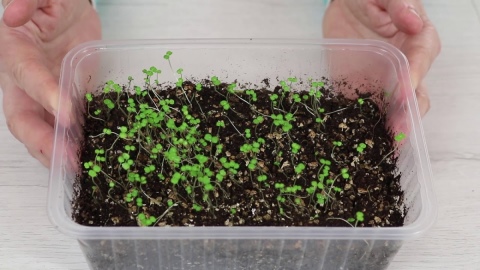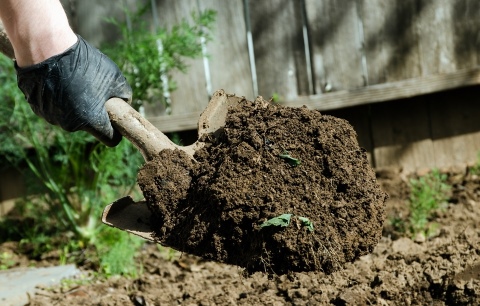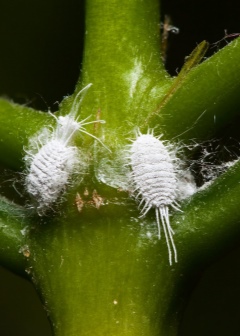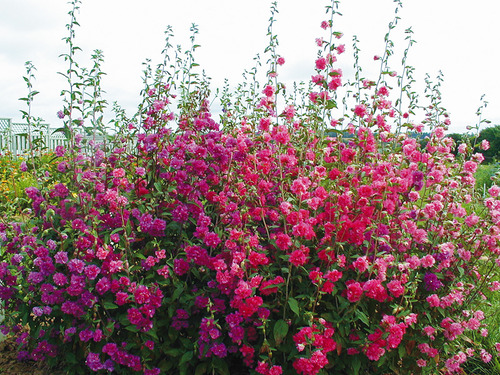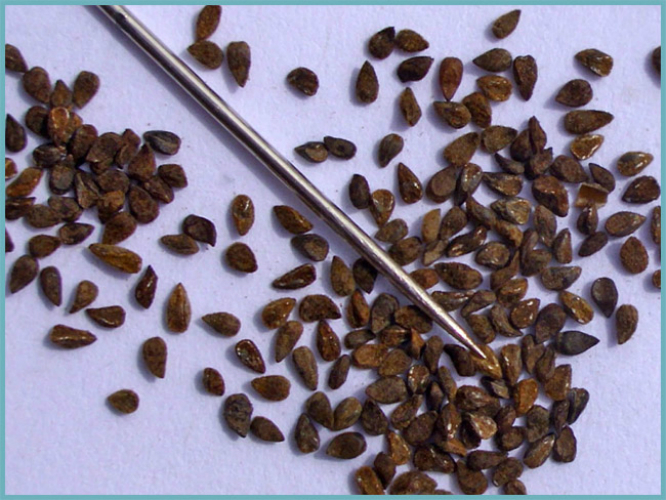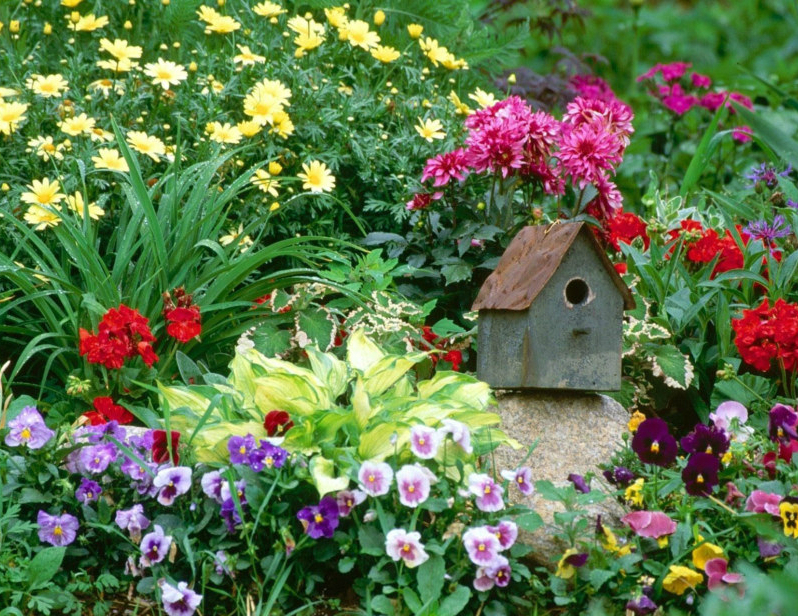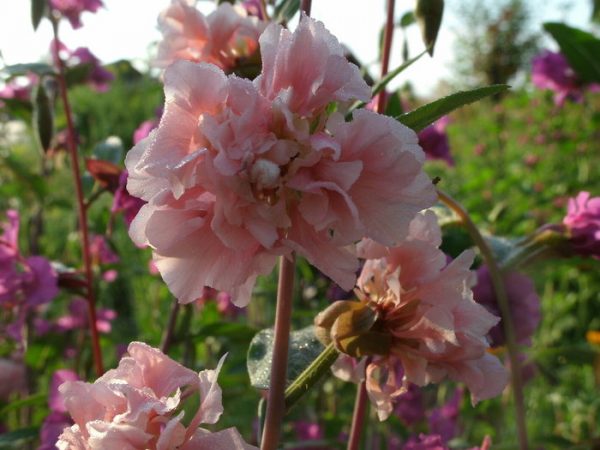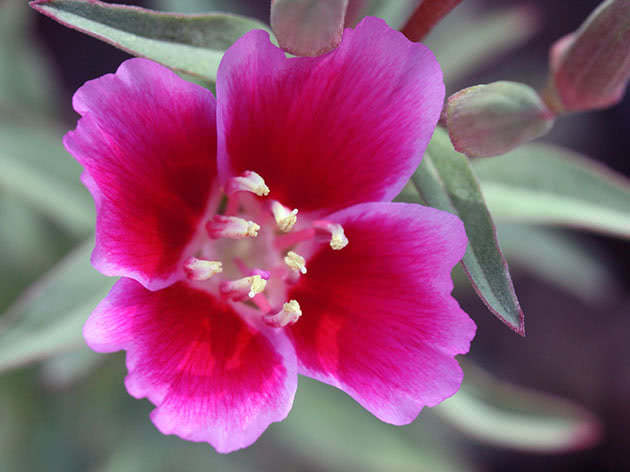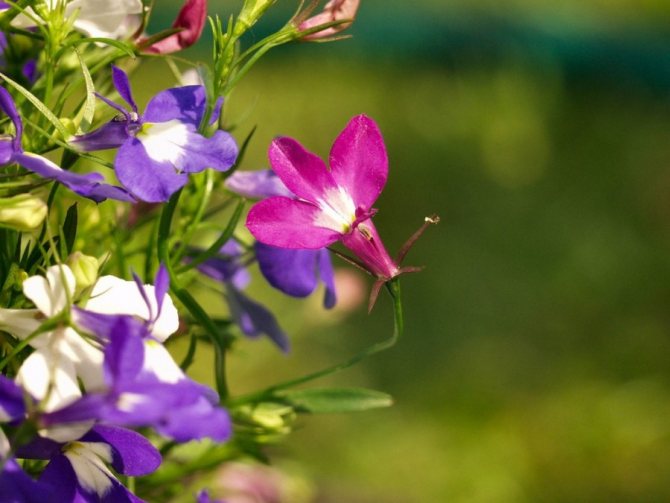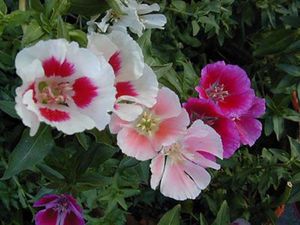Clarkia planting, cultivation and care
Hello my dear readers! Today I want to tell you about another amazing and very beautiful flower that blooms for a very long time and very abundantly.
It will be about such a plant as clarkia, and in this article I will touch on the topic of planting and caring for this beautiful flower. I would like you to turn your attention to the plant, because, despite all the abundance of beautiful flowers, clarkia is also worthy of your attention. Firstly, as I said, it blooms for a very long time and gives a lot of flowers: double, semi-double, pink, white, lilac, purple and so on.
Clarkia flowers are very similar to those of the queen of the garden - roses. Clarkia is an annual plant, its height varies from 30 cm to 70 cm
Firstly, as I said, it blooms for a very long time and gives a lot of flowers: double, semi-double, pink, white, lilac, purple, and so on. Clarkia flowers are very similar to the flowers of the queen of the garden - roses. Clarkia is an annual plant, its height varies from 30 cm to 70 cm.
Her leaves are very beautiful, green. It is advisable to put a support next to the flowers to support the plant. Clarkia can be grown not only in a flower bed, it can decorate your balcony as well as petunia.
This plant has a very pleasant fragrant aroma that attracts bees, therefore it is considered a good honey plant. I hope I persuaded you to plant Clarkia on my site.
Clarkia landing
It is important to choose the right place before planting this plant. It is important to know that this plant loves bright sunlight, so it prefers places where there is a lot of light.
As for the soil, everything is very good here, since it is not at all demanding on the soil.
But if the land is loose and fertile, then this is a huge plus for planting clarkia. In addition, Clarkia loves if the earth is a little acidic. Before planting, you need to prepare the site: they dig it up, add a little humus and mineral fertilizers there. It is not worth making a lot of mineral fertilizers, for 1 m2 it is enough to add 1 tablespoon of superphosphate and potassium sulfate.
Clarkia: reproduction, cultivation and care
Clarkia is propagated by seeds. Seeds can be planted in open ground sometime in early May. After the seeds are sown in the soil, they need to be covered with oilcloth (or any other covering material). The seeds begin to sprout in about two weeks.
When all the seedlings appear, they will need to be sown. There should be about 20 cm between the plants. If you want to have beautiful and compact bushes, then pinch. Caring for clarkeia consists in regular weeding, loosening the soil and watering.
The plant loves water, so if the weather is too hot and dry, it needs to be watered 1-2 times a week. You need to water the plant at the root. The plant also loves feeding.
During the season, 2 dressings are carried out: the first when budding begins, and the second at the beginning of flowering. We use a solution of mullein or bird droppings for feeding. For 10 liters of water, 1 liter of mullein is taken, or 0.5 liters of bird pamet.
Types and varieties of clarkia with photos and names
Only three types of clarkia are cultivated by gardeners, namely: clarkia marigold, or elegant clarkia; clarkia is pretty, or clarke is pubescent; Clarkia Breveri.
Clarkia graceful, or marigold (Clarkia unguiculata, Clarkia elegans)
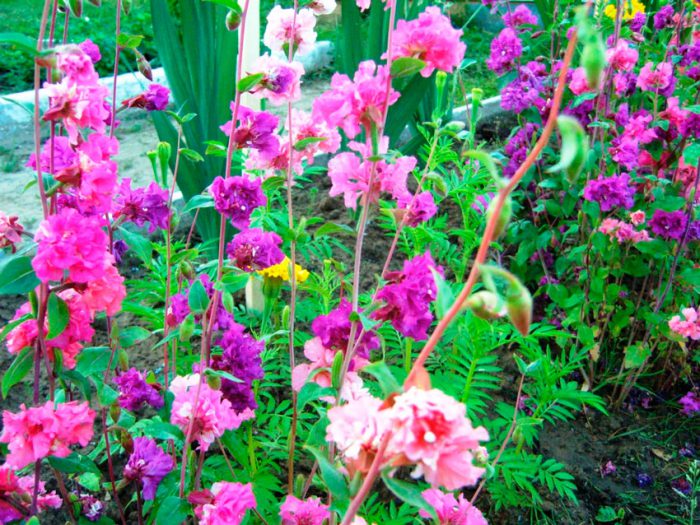
This species can be found in nature in California. A branchy, lush annual plant in height can reach 100 centimeters. Thin enough powerful shoots are lignified from below.On the surface of oval greenish-gray leaf plates there are red veins, their edge is unevenly sparsely toothed. The flowers are regular in shape and four centimeters in diameter. They can be double or simple and have different colors: red, pink, white, purple and blue. They are placed one at a time in the leaf sinuses. Small seeds germinate for about 4 years. It blooms luxuriantly in July – September. This species is often grown in mid-latitudes. The most popular varieties are:
- Albatross. Double flowers are white. A branchy bush reaches a height of about 0.75 m.
- Purpurkenig. Double flowers have a carmine color and a diameter of 35 to 40 mm. The bush reaches a height of 0.8 to 0.9 m.
- Salmon perfection. The double flowers are salmon pink and about 35 mm in diameter. The height of a loose bush is about 0.9 m.
Clarkia pulchella
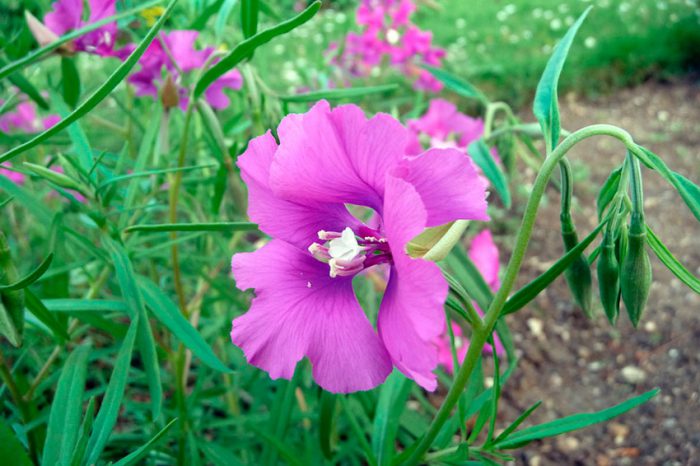
This species is dwarf. Erect, branched shoots can reach a height of 0.4 m. Long, narrow, whole leaf plates are green in color. They sharpen towards the top, and narrow towards the petiole. Flowers can be double or simple. They can be located either singly or be collected in small groups in the leaf axils in the upper part of the stems. Of particular interest is the shape of the petals, which are divided into 3 lobes, spaced quite widely. In this regard, in America, this species is also called "moose horns". Flowering begins half a month earlier than graceful clarkia.
Clarkia breweri

Recently, this species has become increasingly popular with gardeners. This annual cold-resistant plant can reach a height of up to half a meter. The shape of the flower is similar to a butterfly, and in diameter it reaches about 30 mm. The flowers have a pleasant strong smell and are part of loose inflorescences. Pink Ribbons has pink flowers with ribbon-like petals, bush in height can reach about 0.3 m. The shoots of this variety are branched, and it blooms very luxuriantly.
Other types of clarkia grown by gardeners are actually godetia.
CLARKIA
Watch this video on YouTube
Clarkia cultivation methods
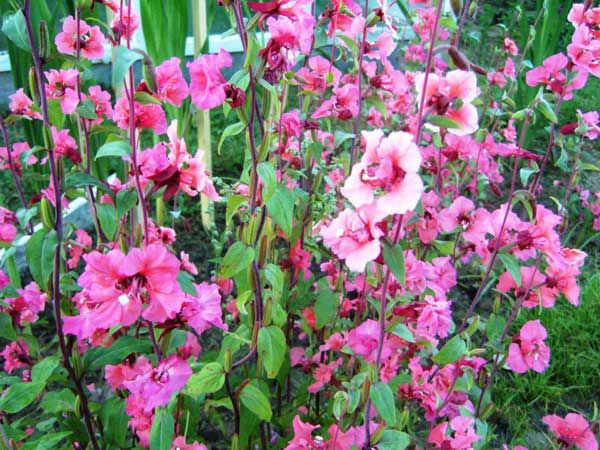
Clarkia, like most annuals, propagates by seed. They can be sown directly into open ground in early spring. The end of April or the beginning of May is the best fit for this work.
In the allotted area, shallow grooves are cut with row spacing of 20 cm. The seeds are mixed with fine sand and sowed. The seeds are lightly pressed against the soil and sprayed with a spray bottle. Watering from a watering can is not recommended, as the seeds may be washed out. After the formation of two true leaves on the seedlings, thinning is carried out, leaving 15-20 cm between the shoots.However, one should not get carried away, since densely growing clarks create more effective compositions.
To protect against flea beetles, the plantings are covered with non-woven material. It will also serve as protection from hot sunlight.
Podzimny sowing is carried out with the onset of cold weather. The seeds should not sprout, but even if this happens, the seedlings will successfully overwinter under the snow and will continue to develop in the spring. Plants grown in this way are distinguished by increased resistance to adverse conditions, and they will bloom in mid-July.
To bring the flowering time closer, many gardeners use the seedling method of growing clarkia.
In March or at the very beginning of April, seeds are sown in shallow containers with loose soil. Since the seed is very fine, almost dusty, it should not be buried.

The seeds are mixed with sand and scattered over the surface, then lightly pressed against the soil and sprayed with a spray bottle. Create the conditions of a mini-greenhouse by covering with a film. The container with crops should stand on a light windowsill without direct sunlight.It will take 10-14 days to wait for shoots.
Seedlings dive at a very early age, since clarkia seedlings do not respond very well to transplantation. After the appearance of the first two leaves, it is better to distribute the seedlings in separate pots. The best option is peat cups, which can be buried in the ground, and the roots will not receive the slightest injury. Transplanting from plastic containers is carried out by the transshipment method together with a lump of earth.
Grown in home seedlings planted on the site at the end of May. At this time, the period of return frosts usually ends.
For reference. When growing clarkia, remember that these are cross-pollinated plants. And if flowers of different varieties are planted nearby, then their seeds will lose their varietal qualities.
Clarkia seedlings dive: video
Features of cleoma

Cleoma has a very powerful root system. Branched strong shoots, on their surface there is pubescence, consisting of glandular short hairs. The height of the bush can be up to 150 cm. Greenish alternate leaf plates in some species have small thorns on the seamy surface. Leaves can be simple or complex: they consist of 5 or 7 entire, elongated linear leaves. The apical leaf plates are small and solid. Apical racemose inflorescences consist from flowers with the correct shape and purple, pink, white or yellow color. The flowers have relatively long stamens that look like spider legs. The fruit is a unilocular polysperm with the shape of a pod, in length it can reach about 30 mm. Most amateur gardeners do not like the flower smell of cleoma, but it is completely impossible to feel it on a garden plot on the street, but it can scare away pests. This unusual aroma is necessary for such a flower to attract small bats in the wild, which are its pollinators.
Flowers blooming beautifully for the garden. Cleoma from seed to flowering!
Sowing
Before sowing the calla, you need to germinate the seeds. To do this, they are placed in warm water for 6 hours. Adding a growth stimulant will not be superfluous. After that, the planting material is placed in a damp towel or gauze, covered with it and sent to heat for about a week. When the towel starts to dry, it will need to be moistened again.
Seeds are planted as follows. Small pits are made in the prepared soil, about 3 centimeters deep. The soil is watered, seeds are placed in it and carefully sprinkled on top. If clay pots are used, the number of seeds in each should be from 3 to 5, this will ensure the emergence of seedlings.

How to grow seedlings from seeds?
Planting a plant is possible in two ways. The first involves planting seeds in the ground, the other - growing seedlings. If you want to create an abundant flower garden, then you should choose the first method. Although it is also possible to grow seedlings at home.
Clarke soil should be nutritious and loose, have a slightly acidic reaction. In heavy soil, it will be difficult for a plant to develop normally. The best option can be considered a substrate where there is leafy earth, sand, peat and rotted humus in equal amounts. Steam or calcine the soil in the oven, so you can prevent possible plant diseases in advance.
Seed preparation
Even during flowering, you need to select 3-4 of the healthiest and most lush flowers. After pollination and isolation, when the capsule has begun to form, its isolation is carried out. The fruit should be tied tightly with clean gauze. The harness is attached to the stem, but not very tight. The seed capsule ripens, the gauze garter does not allow the seeds to fly apart, which excludes self-seeding.
The full ripening of the seeds must be expected a month after the clarkia withers. The seeds turn dark brown, indicating that they are mature.Then the boxes are cut off, the seeds are carefully taken out and dried on a smooth surface. It is convenient to store them in matchboxes or paper envelopes.
Sowing
You need to find a suitable container (either plastic containers or boxes). The soil in it must be prepared, fertilized. It is necessary to make not very deep grooves in it (maximum - 2 cm) with an interval of 4.5-5 cm. Either with paper, or, which is more convenient, with a toothpick, the seed is placed in the grooves, sprinkled with earth and moistened.
Crops then need a greenhouse shelter. You can simply cover the container with foil and put it in a sunny place, for example, on a windowsill. It should be ventilated from time to time and moistened by spraying.
You can expect shoots for 10-12 days. When 2 leaves appear on the sprout, the seedlings need to be planted in separate containers. Peat pots are perfect for this purpose. It is they who are then planted in open ground. It is necessary to transplant seedlings into a garden on a flower bed in the third decade of May. During this period, frosts are rare, so disembarkation usually goes well.
Landing in open ground
If you decide to immediately sow seeds into the ground, then it is better to do it in the fall - the second half of September will be the optimal period. But you can plan a landing in the spring - in this situation, you need to do this in April.
If you decide to plant seedlings in a flower bed, then, as mentioned above, this should be May. In warm regions, late April - early May is possible. In central Russia, it is not worth landing before mid-May.
Clarke's disembarkation step by step.
- Dig up the soil thoroughly 2 weeks before planting, remove old roots from it. At the same time, add universal flower fertilizers to the soil.
- Since the stems of an adult clarke branch significantly, the interval between seedlings should be at least 15 cm.If they are already planted close, they will have to be thinned out - this is the only way to achieve lush flowering.
- The landing pits should not be very deep. If you are planting flowers from a cup, then do it along with a lump of earth. Peat pots are, of course, more convenient in this sense. So the plant is protected from injury.
- You can not separate young bushes, this threatens the death of the plant. Insert a peg into the soil near the bush.
- To stimulate growth and ensure dense branching, the bushes need to be pinched. This should be done when the seedlings grow up to 15 cm.
Further storage
In case of collection in wet weather, decide in advance where the seeds will be sent for storage - this should be a warm room, where the planting material can dry thoroughly and not become a victim of putrefactive processes. When the wet flowers are cut with the stem, they are bundled, tied and hung. As soon as the bushes are well dry, the seeds are taken out of the boxes and poured onto white paper.
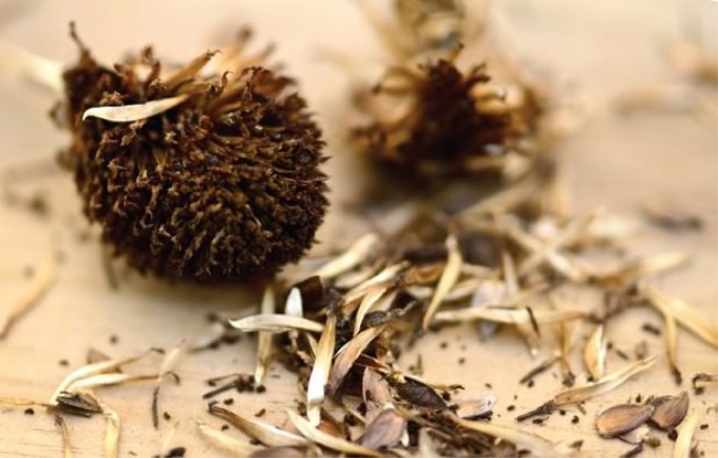
Failure to comply with the storage rules can lead to the fact that the seeds collected with such zeal will lose their germination. Sometimes, due to negligence in storage conditions, diseased and weak plants are obtained from the planting material.
In this regard, it is important to follow several rules.
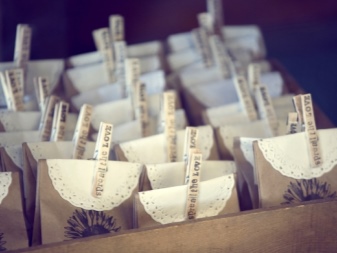



Some gardeners use the lower shelf of the refrigerator as storage, but in this case it is worth making sure that there is no sudden temperature drop. Often a bedside table is used for storage on an insulated loggia.
During storage, it is important to observe the seeds, timely get rid of the specimens affected by the fungus, and change the storage conditions in time in such a situation
While waiting for sowing, seeds can be stored for 3-4 years. Every year, the inoculum is sorted out and unsuitable for planting samples are disposed of.
About, how to collect seeds zinnias, see the next video.

